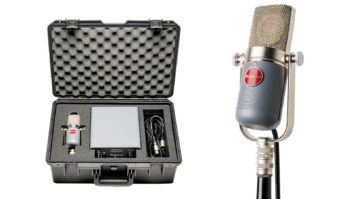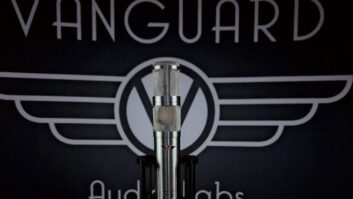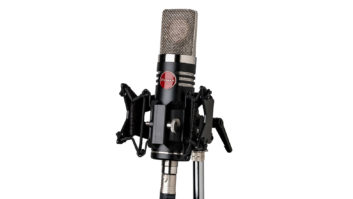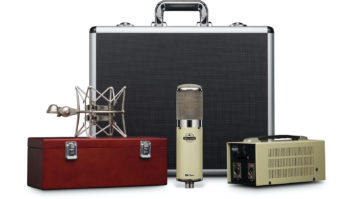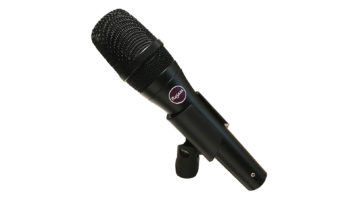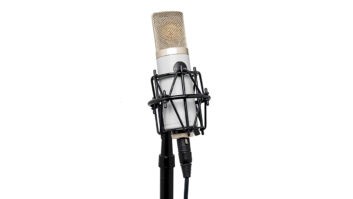
A few trade shows ago, I had a meeting with David Royer and John Jennings in the Royer booth and saw a work in progress — the large-capsule MA-200 cardioid condenser soon to be released under the Mojave banner. Royer mentioned that he had been wrestling with a plant in China about getting it just right. Of course, if you know him, that means just right in 72-point bold type. About a year later, the MA-200 ($995) was released.
The flat-black body and satin-finish grille conceals a 3-micron, gold-sputtered capsule; Jensen output transformer; and military-grade JAN 5840 vacuum tube wired for triode operation. The mic ships in a small carrying case inside a larger, sturdy carrying case housing the external (100/115/230VAC, 50/60Hz) power supply, shock-mount and mic cable. Frequency response is listed as 30 to 18k Hz, ±2.5 dB, with A-weighted self-noise of 14 dB. Clipping is measured at various frequencies: 132 dB at 20 Hz; 135 dB at 32 Hz; 136 dB at 100 Hz; 136 dB at 1 kHz; and 136 dB at 10 kHz.
LET’S GET IT ON
I’ve had a chance to test a pair of the MA-200s in a number of situations, and the surprises were always pleasant. First off, I placed them in a spaced array over a drum kit with 10/14/16-inch toms, 18×22-inch kick and a 5×14 snare. The mic preamps were from a freshly recapped SSL 4000 G directly to a 2-inch Studer A827 recorder. The first thing I listen for in an overhead mic is how it handles cymbals and stark transients. The MA-200 imparted smoothness to the cymbal crashes and was never strident or washy.
Later that same day, the mics were used on the same kit in the room as knee-highs, about five feet back from the front of the drums. In this application, the kit was well-balanced and added a nice texture to the mix when added to the rest of the miked kit. On a later session, I heard the mics on a completely different drum kit recorded to an Otari RADAR at 48kHz/24-bit. The results were equally good. When the noise floor of the analog tape was removed, you could hear that the personality heard in the first application was not supplied by tape compression, but from the mics.
On a third session, I had a remarkable experience when the overhead drum mics were sent through API’s new A2D dual 312 mic preamps. I just used the analog stage of the unit and sent the mics directly to the RADAR. Later, I was able to grab the EQ on the SSL and dig out plenty of low- and top-end butter with very little gain. When paired with an excellent preamp, this mic is simply gorgeous.
Next, I heard the Mojave mics in an X/Y configuration in front of an acoustic guitar through a Neve VR console recorded directly to an Otari MTR-90 analog multitrack. The stereo image was very good, and the mics gave a very nice picture of the guitar without being boomy. They sat nicely in the track with a little help from some EQ at the top end.
Although I never expected it, the MA-200 did a fine job on a male vocal, imparting throaty warmth, a bit of transient crunch and an evenness that made the “ears” in the room smile at the results. When you have a mic that can cover instrumental and vocal duties in this price range, you’re playing with house money.
The mics fared equally well when placed over the harp of a Yamaha C5 grand piano. From piano to forte, the MA-200s imparted a fine tone.
Last, the MA-200 was used on a screaming Fender Metal Head guitar amp. This particular tune needed various groaning and otherwise annoying distortion as added ear candy and the Mojave stood up very well under the strain. It was literally so loud that mere humans had to vacate the room, leaving all but the ear-plugged guitarist and the MA-200 to take the abuse. Once again, it did a journeyman’s job and never buckled under the onslaught of abusive SPLs.
GIVE ME MO’ MOJAVE
I really like this mic, but if you’re looking for pristine reproduction of your selected source, look elsewhere, because the one word that defines the MA-200 is personality. Time and time again, I put the mic into varying situations and it shined. What I like most is that when you hit it hard, the MA-200 gives you back some crunch. The plate-loaded tube stage rounds out transients nicely, giving it an almost ribbon-like quality. I know that’s counterintuitive — this is a condenser after all — but that’s what I heard. The high end is not overly bright and the mids and lows are well balanced and full.
I would never expect a mic at this price range to be a decent vocal mic, but it reproduced the male voice nicely. In this application, with this singer, it was a bit lacking in the bottom end, but a bit of EQ at 100 Hz dressed it right up, making it an easy winner over other mics with the same pedigree. If you’ve got a kilo-buck to spend and you’re looking for a mic, you’ve got to check out the MA-200.
Mojave Audio, 818/847-0222, www.mojaveaudio.com.
Kevin Becka is Mix’s technical editor.
